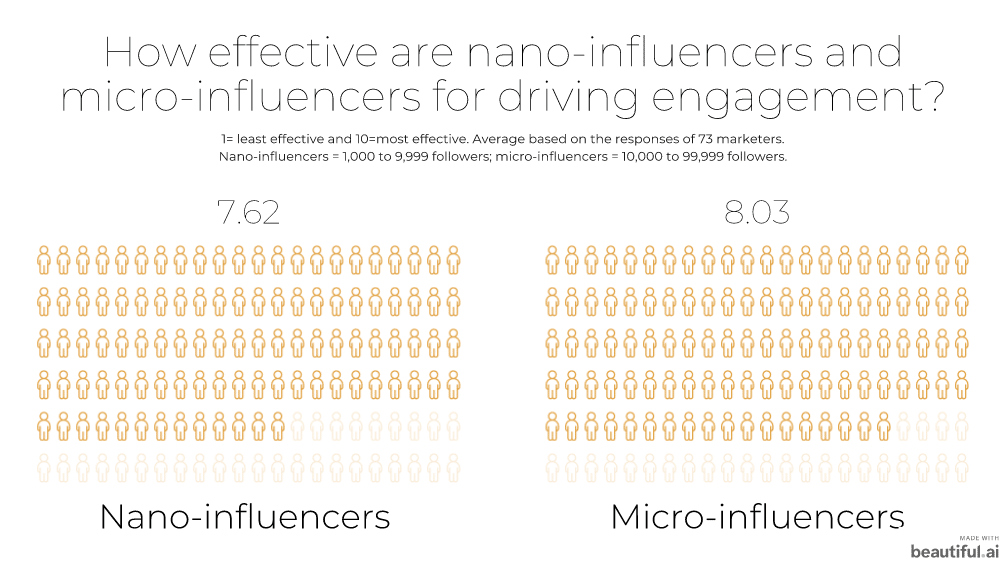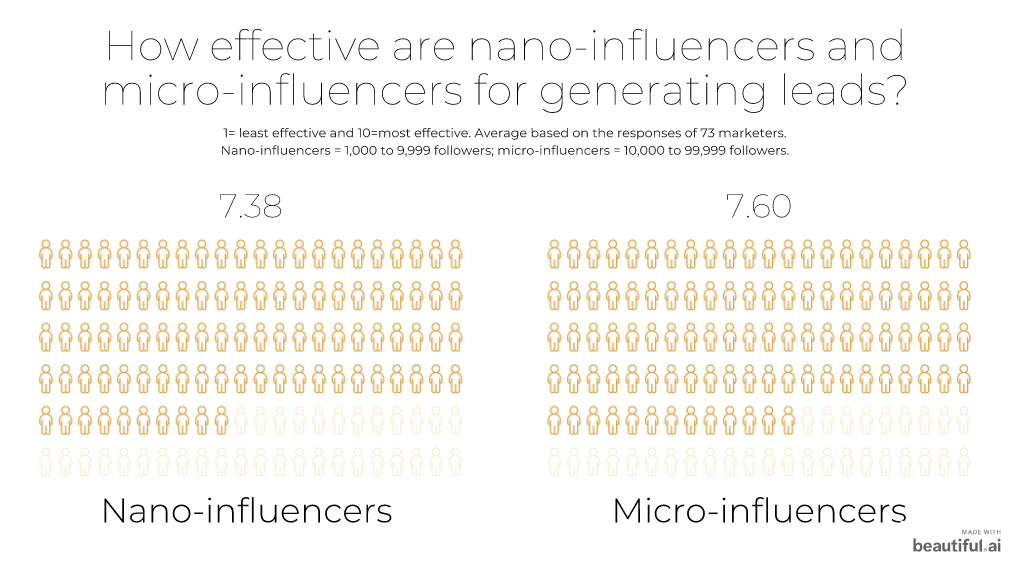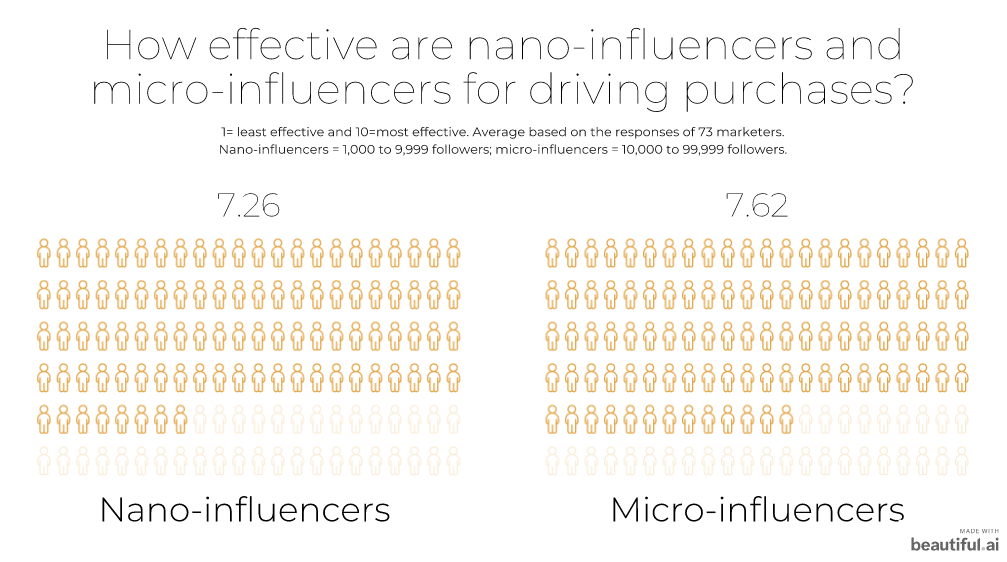You’ve probably seen all the brands winning more customers with influencer marketing.
On the other hand, getting the most value from influencers demands extensive research. – even if you’re not working with big-name celebrities.
At the end of the day, is it still worth working with influencers?
In this guide, we focus on nano- and micro-influencers (in contrast with macro-influencers), and the pros and cons of partnering with them for your brand.
Nano- and micro-influencers rated a 7.8 out of 10 for engagement
When we previously compared macro-influencers and micro-influencers, we found that smaller influencers tend to deliver higher engagement rates.
But how do these smaller influencers rate on engagement, as a stand-alone metric?
Based on our own survey, experts agree – nano- and micro-influencers are very effective at driving engagement.
On a scale of 1-10, with 10 meaning most effective:
- Experts rate nano-influencers a 7.62 for effectively driving social media engagement.
- They rate micro-influencers an 8.03 for effectively driving social media engagement.
So, that’s an average engagement rating of 7.83 for nano- and micro-influencers.

We dive into more benefits of nano- and micro-influencers below, including how effective influencers are for generating leads and driving purchases.
Advantages of working with nano- and micro-influencers
From tapping into an engaged audience to working directly with the individual creators, there are a ton of advantages of working with influencers.
Let’s look at what the experts say:
1. Highly targeted audience
In comparison with macro-influencers, who have a wide follower pool, micro-influencers have a small but targeted audience.
“A large percentage of their audience is following them for very specific reasons,” observes Iain Miller of Unique Ascent.
“If your niche is the same as theirs or similar, your target audience will be the same. The huge advantage these smaller influencers have is you can target the exact demographic that works for your business.
“As a result, you can build a following of like-minded individuals, rather than a huge collection of anyone to get numbers up. This will result in a greater percentage of your audience actually buying from you.”
Most of our respondents agree that small influencers are a great help in generating leads. On a scale of 1-10, where 1 is least effective and 10 is most effective, our respondents rate:
- Nano-influencers a 7.38 in effectiveness for generating leads
- Micro-influencers a 7.60 in effectiveness for generating leads

“If [a nano- or micro-influencer’s] audience is a good fit for your business, the value of their references is higher than larger influencers with a broader type of audience,” in the words of Melanie Musson of Clearsurance.com.
SBO’s Mario Cacciottolo backs this point. “Businesses that use nano- and micro-influencers are targeting a specific group of people they know they can attract to their product or service.
“Many bigger influencers have a large casual follower base on top of their fan base, who may not buy into their influence in the same way a smaller devoted audience does with nano- and micro-influencers.”
2. More engagement
Because nano- and micro-influencers have a small audience, they are able to form solid relationships with their followers.
RegionalFoundationRepair.com’s Don Adams points out: “Nano- and micro-influencers have a stronger relationship with their followers.
“Their followers have more faith in their choices and are more likely to convert. They are following these influencers because of the valuable content they share, not just because they are famous.”
“Their viewers and followers see their opinions on this matter as authentic and trustworthy as a result of their experience,” agrees Sep Niakan from Condoblackbook.
“When a brand chooses to work with micro-influencers who cater to a certain demographic of followers, they are more likely to achieve a greater conversion rate than when they engage with big influencers.”
Our respondents rate nano- and micro-influencers highly when it comes to driving purchases.
On a scale of 1-10:
- Nano-influencers received a 7.26 rating for driving purchases.
- On the other hand, micro-influencers received a rating of 7.62 for driving purchases.

3. Authentic followers
As Harry Johns White of NBA Blast shares, you don’t have to worry about fake engagement with smaller influencers. “The authenticity of their followers is 100% credible. Having smaller follower numbers means the engagement and reach is more genuine. There’s less chance for bot interference, follower duplication, fake follower profiles, and shady amplification tactics.”
As a result, you can have confidence that the high engagement rates from smaller influencers are genuine.
4. More personal connection to followers
Mark Valderrama from Aquarium Store Depot shares, “Celebrity and macro-influencer endorsements never feel completely genuine, as those people always appear to be distanced from their followers.
“But if you follow a micro-influencer who shares your interests, you can connect with their pain, feel their happiness, and understand them. You assume they, in turn, are capable of understanding you and your difficulties.
“Micro-influencers are very similar to their supporters, which is usually what makes them so popular in the first place. If a micro-influencer actually enjoys a brand, odds are that their followers will be equally interested.”
Peter Thaleikis from Which Login echoes this view: “Small influencers can create a much more personal connection with their followers because they are talking on a level that is relatable and human. This drives engagement and helps position your campaign in the right light.”
Think of it like this: The smaller an influencer’s audience, the more they can get to know and engage with their followers. As a result, their influence is much stronger.
5. More accessible to brands
Says Peter Thaleikis: “You are also likely to notice that smaller influencers are more accessible.”
“Larger influencers will often have an agent who will negotiate on their behalf. This is because they have a lot of work on their hands and need to make sure that the brand is a good fit.
“With smaller influencers, they might not have this luxury. You might even be their first engagement with the business side of being an influencer. If you invest the time in building a good relationship, you are likely to benefit from lower costs as their accounts grow.”
In addition, smaller influencers usually have more time and creative bandwidth to devote to your brand.
6. Cost-effective collaboration
Melanie Musson of Clearsurance.com observes, “Working with nano- and micro-influencers is typically less expensive than working with larger influencers, making the cost/benefit ratio more in your favor.”
Joe Kok from Good Cloud Storage agrees. “Micro-influencers are affordable for small businesses and have a higher conversion rate. Despite having fewer followers and more niche markets, they have a solid connection and engagement with them.”
Despite the lower expense, bear in mind that you shouldn’t be focused on saving money.
It’s understandable some businesses have a lower budget. However, if you try to pay less than influencers are worth, you may end up with poor quality work that reflects the payment you’re offering.
The key to seeing success with influencers is “showing interest and appreciation for what they do and building rapport when you reach out. Try to gauge their interest before making an offer, and go from there. This increases the likelihood of a more beneficial and affordable partnership,” shares Nikita Chen from LegitGrails.
7. Greater ROI
Choice Mutual’s Anthony Martin tells us: “Working with nano-influencers and micro-influencers delivers more return on your investment.
“It’s easier to build loyalty because these influencers can personally respond to more of their followers’ messages and questions. This makes followers feel more heard compared to audiences of those with more significant followings.
“In return, when you invest in smaller influencers, their followers will be more intrigued by their recommendations, and more likely to purchase from your website.”
8. Better geographic targeting
“Since nano- and micro-influencers have a stronghold over a specific geographic area, they can hugely benefit small businesses in a certain town or area of a city,” Brian Nagele of Restaurant Clicks highlights.
“For example, if a new restaurant was opening in a busy neighborhood, a micro-influencer could help them stand out from the crowd.
“Plus, since micro-influencers operate on a smaller scale, they generally have a high level of trust and engagement from their followers, making them all the more valuable.”
9. Easier to work with
According to Harry Johns White of NBA Blast, “The number of followers a nano- or micro-influencer has is no barrier for them to participate in sponsored post agreements with brands.
“They can be as picky as large influencers when it comes to the product they endorse – but they’re more likely to accept an endorsement agreement.”
In other words, there’s a good chance the nano- and micro-influencers you want to work with will work with you.
Adding to these advantages, Olive’s Paul Sherman notes, “They tend to be cheaper, more humble, and easier to work with because they haven’t hit the fame of millions of followers yet.
“You also don’t have to work through their agents or communications team because, once again, they’re not famous enough to have any yet.
“While you reach fewer customers with micro-influencers, you’ll likely have more engagement and conversion with them.”
Disadvantages of working with nano- and micro-influencers
Now for the downsides of working with smaller influencers:
1. The right influencers are hard to find
Jon Bennion from Online Marketing Gurus USA opines, “It can be difficult to find the ideal candidate to work with.
“This is because you want to collaborate with an influencer with a following that matches your target audience and high engagement rate.
“This person should be capable of creating great content and be still affordable. All these factors can be difficult to find in a single influencer.”
Pro tip: Keep an eye out on industry influencers, whether or not you’re actively looking to work with one. Maintain a swipe file of nano- and micro-influencers you think can be a good fit. So when you’re ready to collaborate, you’ll have a list of names to reach out to and possibly recruit.
Don’t miss our previous roundups on tips to find smaller influencers and recruit them!
2. Less experienced with the ins-and-outs of influencer marketing
In contrast with macro-influencers, nano- and micro-influencers don’t have extensive experience working with brands.
Lisa Richards from The Candida Diet comments, “One of the disadvantages of working with nano-influencers is their inexperience in working with businesses. They may be adept at navigating social media, but working with brands is a different playing field for them.
“They are not accustomed to making deals and negotiations, which may complicate things in the process.”
And as Mario Cacciottolo from SBO highlights, “You don’t want to be associated with a social media storm because a smaller influencer has posted something that has caused a backlash.
“This is still possible with the bigger influencers, but as they gain more followers, it appears influencers become more trained with what not to say.”
Alluding to the same concern, Paige Arnof-Fenn of Mavens & Moguls comments, “The risk is that they get caught saying or doing something inconsistent with your core values and your brand’s reputation gets tarnished. So, due diligence is crucial with social media archives and videos so easily accessible today.
“I have had good experiences working with them, but doing your homework is key to success.”
Simple Solar Living’s Eric Thomas has a similar experience. “Nano-influencers can be less professional. Some nano-influencers are really only getting started, so they might be quite green in terms of their business acumen. It’s important that you create contracts for all your influencers you create deals with.”
3. Limited reach
“One disadvantage of using nano-influencers and micro-influencers is the lack of reach they have,” says Milo Miszewski of mDevelopers.
“Their audiences are typically smaller than those of larger influencers, so brands may not be able to achieve the same level of exposure by working with them.
“Additionally, micro-influencers may not have as much experience or be as skilled at promoting brands and products, which could result in poorer quality content.”
Hima Pujara of BugRaptors makes the same point. “They have limited reach as compared to larger influencers. If you are planning to reach a wide audience then managing the number of nano-influencers can be more costly than targeting one macro influencer.”
4. More work on your plate
“When it comes to managing and monitoring social media marketing campaigns, using nano- and micro-influencers means more work for brands,” Charles Cridland of YourParkingSpace opines.
“Tracking the performance of a network of hundreds of influencers is substantially more complicated than monitoring just a few macro-influencers.
“And you’ll also need more time for vetting smaller names and then managing them in terms of content and payment.”
Documenting your process and creating contracts and guidelines for nano- and micro-influencers can help reduce work in the long run.
Summing things up
Even though working with nano- and micro-influencers has its drawbacks, the pros of leveraging these small influencers far outweigh the downsides. They bring a high level of trust and relationships built among their dedicated followers.
By applying the expert tips we’ve gathered, you can easily overcome most of the cons when working with smaller influencers.
Ready for these ROI-boosting tips on leveraging nano- and micro-influencers? We’re sharing them in our other roundup on leveraging smaller influencers.




